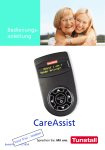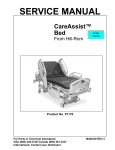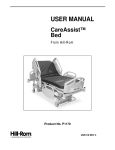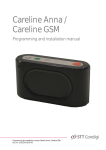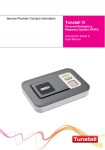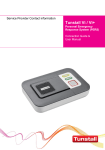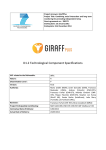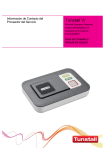Download CareAssist Programming and user guide
Transcript
Programming and user guide CareAssist 68100/01 D6707281B Programming and user guide Introduction CareAssist is designed to support local carers to deliver high quality, non-intrusive care. It is extremely easy to use, portable device that provides carers working or living onsite with a means to receive instant alerts from Tunstall’s range of telecare sensors. As a result, onsite carers can be quickly made aware of any incidents allowing them to provide a high level of care whilst maximising their efficiency. It provides a very cost effective telecare solution whilst avoiding the need for a telephone line or monitoring centre service which is often not required when full time (24 hour) care is being provided. The CareAssist has a radio range in free space of up to 200m and has a battery life of up to 12 hours (depending on usage). Page 2 of 24 Programming and user guide Contents What’s in the box .................................................................... 4 Key features............................................................................. 5 Display symbols...................................................................... 6 How to set up for the first time ............................................. 7 How to program ...................................................................... 8 Entering programming mode ........................................................... 8 Exiting programming mode.............................................................. 8 Adding a trigger................................................................................ 9 Removing a trigger......................................................................... 10 Editing a trigger.............................................................................. 11 Viewing Triggers ............................................................................ 12 Locations........................................................................................ 12 Adding a Location................................................................................... 13 Removing a Location.............................................................................. 13 Editing a Location................................................................................... 14 Setting Time and Date ................................................................... 14 Changing Settings.......................................................................... 15 Alerts ...................................................................................................... 15 Radio Walk Test ..................................................................................... 16 Service Menu.......................................................................................... 16 Alarm History ................................................................................. 17 View Locally............................................................................................ 17 Send to PC ............................................................................................. 18 Switch Off....................................................................................... 20 How to manage alarms ........................................................ 21 Acknowledging an alarm call .................................................................. 21 Managing multiple alarm calls ................................................................ 21 Battery Information............................................................... 22 Accessories ........................................................................... 22 Notices ................................................................................... 23 Declaration of conformity .................................................... 23 Technical Details................................................................... 23 Page 3 of 24 Programming and user guide What’s in the box CareAssist Antenna Port Pager Output Port Charging Socket (USB) Keypad Antenna Belt clip and screw Charger User Guide Page 4 of 24 Programming and user guide Key features The CareAssist is designed to be extremely easy to use and understand. It includes the following features: Multiple alert modes – the unit can alert the carer using audible alerts, on screen message and a vibration mode. The audible alerts and vibration mode can be turned off if necessary. Date and time – providing that the time has been set, the current time will be shown on the screen. The set date and time will also be used to log the alarm history in the CareAssist’s memory. Keypad lock – if the keypad is not pressed for 30 seconds, the keypad will be locked and a key symbol will be displayed on the screen. View and download alarm history – the alarm history including the time the alarm was received and the time it was acknowledged (cleared) is held on the unit’s memory and can be viewed on the screen or downloaded to a PC. Flexible monitoring period – when using a Universal Sensor (only when set to send ‘Door’, ‘PES Wander’, ‘Bed Absence’ and ‘PIR Standard’ radio messages) or PIR movement sensor, the CareAssist provides the ability to only alert the carer to trigger activations during a specified period of time each day. For example, to only receive activation alerts from a bedroom door during the night. The date and time must be set in the unit for this feature to operate. Pager compatible – the CareAssist has a pager output port that enables alarm messages to be sent to pagers worn by carers (this requires additional products see accessories on page 22 for more details). Page 5 of 24 Programming and user guide Display symbols Symbol flashing Meaning Description Battery indicator 1 bar = 25% charged 2 bars = 50% charged 3 bars = 75% charged 4 bars = 100%charged Low battery Battery should be charged Keypad locked Press and hold select key to unlock keypad Time Silent mode Audible alerts disabled Down arrow Press down key to scroll to next menu item Up arrow Press up key to scroll to next menu item Right arrow Press right key to scroll to next menu item Left Arrow Press left key to scroll to next menu item Page 6 of 24 Programming and user guide How to set up for the first time To set up the CareAssist follow the below steps: 1. 2. 3. 4. If the CareAssist is to be used as a portable device, attach the belt clip to the back of the CareAssist and then fit the screw to permanently fix it in place. A – Back of the CareAssist with the belt clip fixing points B – Squeeze the top of the belt clip and fit in to the fixing points C – Fit the screw to permanently fix the belt clip D – Belt clip is now fixed Connect the CareAssist to the USB charger provided then plug it into a mains power socket and charge for an initial period of 24 hours. It is now advisable to perform a range test around the building in which the CareAssist will be deployed to ensure it provides sufficient coverage (see Radio Walk Test on page 16 for details). The antenna can be screwed into the antenna port to improve the radio range of the unit. The Antenna does not have to be used where the radio coverage is sufficient. You are now ready to program the CareAssist. Page 7 of 24 Programming and user guide How to program In order to program the CareAssist you first of all need to enter programming mode. Entering programming mode To enter programming mode, ensure the keypad is unlocked then press and hold the select key until the unit beeps. displayed), press and hold the If the keypad is locked ( select key to unlock it, then press and hold the select key again to enter programming mode. The CareAssist will then display the first item (Add Trigger) in the programming menu. NOTE: The word ‘Trigger’ refers to any 869MHz radio trigger or telecare sensor. Programming mode will automatically time out if the keypad is not pressed for a 60 second period. Exiting programming mode To exit programming mode, press the up/down keys to ‘Exit’ then press select. The CareAssist will return to its normal mode. NOTE: Unless the unit is in ‘Walk Test’ mode, programming mode will automatically be exited if an alarm is received. Page 8 of 24 Programming and user guide Adding a trigger Step 1 - In programming mode, use the up/down keys to display ‘Add Trigger’ then press the select key. Step 2 - The CareAssist will then display ‘Please Press Trigger’. Then activate the trigger/sensor that is required to be added. Step 3 – The radio trigger’s ID number will then be displayed. Check the radio trigger ID displayed matches the ID on the small label on the trigger/sensor (see below). The Trigger ID is a 6 digit number normally Step 4 – If the Trigger ID matches, press displayed in the top right of product labels. select. If the ID doesn’t match then more than one trigger may have been received. In this case, use the down key to display the correct ID, then press select. Step 5 – You must then assign a location to the trigger. Use the up/down key to scroll to the required location then press select. If Custom Locations have been programmed, they will be displayed before the default locations. Step 5a – When adding a Universal Sensor (only when set to send ‘Door’, ‘PES Wander’, ‘Bed Absence’ and ‘PIR Standard’ radio messages) or PIR movement sensor, the CareAssist provides the ability to only alert the carer to trigger activations during a specified period of time each day e.g. at night. In this case, the unit will ask you to set the ‘Monitoring period’. You can then select either: 24 Hour - the unit will monitor trigger activations 24 hours a day. Configure – the unit will ask you to input a start/end time and will only generate alerts for trigger activations received during this period. The date and time must be set correctly in the unit for this feature. Step 6 – A confirmation tone will be emitted after successfully adding the trigger. NOTE: If a location is not assigned the trigger will not be added to the CareAssist. Page 9 of 24 Programming and user guide Removing a trigger IMPORTANT: Removing triggers may affect the events held in the memory of the CareAssist. Therefore before removing triggers it is advisable to download any history you wish to keep (see Alarm History section). Step 1 - In programming mode, use the up/down keys to display ‘Remove Trigger’ then press the select key. Step 2 – Scroll to or activate the trigger you wish to delete. When the correct trigger ID is displayed, press select. Step 3 – Confirm that you wish to remove the trigger and a confirmation beep will be emitted. Step 4 – To exit, press the down arrow key until the word ‘Exit’ is displayed then press select. Page 10 of 24 Programming and user guide Editing a trigger IMPORTANT: Editing triggers may affect the events held in the memory of the CareAssist. Therefore before editing triggers it is advisable to download any history you wish to keep (see Alarm History section). Editing a trigger enables you to change the location assigned to a trigger. Step 1 - In programming mode, use the up/down keys to display ‘Edit Trigger’ then press the select key. Step 2 – Scroll to or activate the trigger you wish to edit. When the correct trigger ID is displayed, press select. Step 3 – Then scroll to a new location and press select to confirm the change. A confirmation beep will be emitted. Step 3a – When editing a Universal Sensor (only when set to send ‘Door’, ‘PES Wander’, ‘Bed Absence’ and ‘PIR Standard’ radio messages) or a PIR movement sensor, the CareAssist provides the ability to only alert the carer to trigger activations during a specified period of time each day e.g. at night. In this case, the unit will ask you to set the ‘Monitoring period’. You can then select either: 24 Hour - the unit will monitor trigger activations 24 hours a day. Configure – the unit will ask you to input a start/end time and will only generate alerts for trigger activations received during this period. The date and time must be set correctly in the unit for this feature. Step 4 – To exit, press the down arrow key until the word ‘Exit’ is displayed then press select. Page 11 of 24 Programming and user guide Viewing Triggers By selecting ‘View triggers’ you can easily view all the triggers that are currently programmed to the CareAssist. This includes the Trigger ID and type. By pressing and holding the right key you can also temporarily view the location assigned to the highlighted trigger. To exit, press the down arrow key until the word ‘Exit’ is displayed then press select. Locations Whilst all triggers and telecare sensors have a list of preprogrammed locations available to choose from you can personalise the CareAssist by adding custom locations. The custom location replaces the location information that is presented during an alarm call. Custom locations can be used to display a resident’s name or, where it is important to have a location; both the resident’s name and a location could be added. Where both a resident’s name and location is required, a custom location for each of the resident’s rooms will need to be added. For example. Custom location 1 – Deborah’s living room Custom location 2 – Deborah’s bedroom In multiple person complexes it may be more appropriate to just display the person to whom the trigger is associated. For example; Custom location 1 – Deborah Custom location 2 – Helen Page 12 of 24 Programming and user guide Adding a Location Step 1 - In programming mode, use the up/down keys to display ‘Add Location’ then press the select key. Step 2 – To edit the location text, press the up/down keys to scroll to the letter/symbol you wish to use then press the left/right keys to move to the next space. Step 3 – Press select when you have completed the custom location text and a confirmation beep will be emitted. Removing a Location IMPORTANT: Removing locations may affect the events held in the memory of the CareAssist. Therefore before removing locations it is advisable to download any history you wish to keep. Step 1 - In programming mode, use the up/down keys to display ‘Remove Location’ then press the select key. Step 2 – Scroll to the location you wish to delete. When the correct location is displayed, press select. Step 3 – Confirm that you wish to remove the location by highlighting ‘yes’ and pressing select, a confirmation beep will be emitted. Page 13 of 24 Programming and user guide Editing a Location IMPORTANT: Editing locations may affect the events held in the memory of the CareAssist. Therefore before editing locations it is advisable to download any history you wish to keep. Step 1 - In programming mode, use the up/down keys to display ‘Edit Location’ then press the select key. Step 2 – Scroll to the location you wish to edit. When the correct location is displayed, press select. Step 3 – To edit the location text, press the up/down keys to scroll to the letter/symbol you wish to use then press the left/right keys to move to the next space. Step 4 – Confirm that you wish to save the changes by highlighting ‘yes’ and pressing select, a confirmation beep will be emitted. Setting Time and Date IMPORTANT: The date and time must be set correctly on the CareAssist as the time and date is logged in the unit’s history. If the CareAssist battery runs out and is not recharged the Time and Date should be checked to ensure it hasn’t reset. Step 1 - In programming mode, use the up/down keys to display ‘Set Time/Date’ then press the select key. Step 2 – Press up/down keys to display either ‘Time’ or ‘Date’ then press select. Step 3 – To edit the time/date, press the up/down keys to change the number and the left/right keys to move to the hours/minutes/day/month/year. Step 4 – Press select when the correct time/date is displayed, a confirmation beep will be emitted. To exit the Time/Date menu, use the up/down keys to display ‘Back’ then press select. Page 14 of 24 Programming and user guide Changing Settings In programming mode, use the up/down keys to display ‘Settings’ then press the select key. You will now be presented with the settings menu. To exit the settings menu, use the up/down keys to display ‘Back’ then press select. Alerts The alerts menu item enables you to configure how the unit should alert you when an alarm is received. Use the up/down keys to display ‘Alerts’ then press select. Then follow the on screen instructions to: • • • Enable/Disable Audible Alerts Set Alert Volume Level – High or Low Enable/Disable the Vibration mode Highlight ‘Yes/No’ then press select to confirm each alert setting. Page 15 of 24 Programming and user guide Radio Walk Test IMPORTANT: Genuine alarm calls will only display as a range test when the CareAssist is in Walk Test mode and will not be registered in the unit’s history. This feature allows you to test the radio range around the building by continually activating triggers and receiving audible alerts to verify the radio transmission has been received. To enter walk test mode, enter programming mode by holding down select then press select when ‘Radio Walk Test’ is displayed. Then activate the trigger/sensor at different points in the building to assess the radio performance/range within the building. Walk test mode can be exited by pressing the select key at any time alternatively, Walk Test mode will time out after a period of inactivity. In Walk Test mode, Audible alerts will only be emitted if the trigger is already programmed into the CareAssist. Triggers not programmed into the unit will just display their trigger type and ID number on the screen. NOTE: The range of the unit is up to 200m (line of sight) however the overall radio performance in buildings is dependant upon a number of conditions including the building type, wall thicknesses, insulation type etc. Service Menu This menu provides access to Pager settings, Radio Diagnostics, Battery Status, Software Version Info, Restore Defaults and a complete unit Shutdown. It is only accessible by authorised individuals. Page 16 of 24 Programming and user guide Alarm History IMPORTANT: The history is altered when triggers/locations are edited and deleted therefore it is advisable to download the unit’s history before performing these tasks. The Time/Date must be set correctly to use this feature. The history of alarms received and acknowledged (cleared) is held in the unit’s memory. The memory has a capacity to hold the last 256 events. The history can be viewed locally (on the CareAssist screen) or can be downloaded to a PC. View Locally After entering Alarm History, press select when the screen displays ‘View Locally’, the CareAssist will then display the history held on its memory in the following format. Memory event number Total events in memory Action (Raised or Cleared) View next event Alarm information (display will scroll between (alarm type, location, date and time, trigger ID) Page 17 of 24 Programming and user guide Send to PC The unit’s history can be downloaded to a PC using HyperTerminal which is a program available on standard Windows based PCs. The program is also available from www.hilgraeve.com and free versions are also available from many other websites. Step 1 – Connect the CareAssist to your PC using the PC download lead (see accessories) and a USB to RS232 adaptor (if required). Step 2 – Go to the ‘Start’ menu on your PC, and select the following go to the following folder ‘All Programs / Accessories / Communications’, then click on HyperTerminal. Step 3 – Create a new connection by typing in the name ‘CareAssist’ and clicking OK. Step 4 – on the Connect to screen, change the ‘Connect using’ drop down box to the correct COM port then click OK. To establish which COM port your PC is using. a. Open your PC’s System Properties and select the Hardware tab, then click Device Manager Page 18 of 24 Programming and user guide b. Scroll down to Ports (COM & LPT) and click on the + symbol, then see which COM port is being used (example COM5 is the port being used for the USB adapter cable). You can then close the device manager. Step 5 – Ensure the COM port properties are set correctly (see below) then click OK Bits per second Data bits Parity Stop bits Flow control - 9600 8 None 1 None Step 6 – In the HyperTerminal menu select Transfer, then either ‘Capture Text’ (saves as a text file) or ‘Capture to Printer’ (prints the history) and select the appropriate file/printer. Step 7 – Go to CareAssist programming menu by holding down the select key. Scroll down to ‘Alarm History’ then press select. Scroll to ‘Send To PC’ then press select and the history will be transferred into HyperTerminal. Step 8 – Exit HyperTerminal and when asked ‘Do you want to save the connection named “CareAssist”?’, click yes. Page 19 of 24 Programming and user guide Step 9 – the next time you open HyperTerminal, you can directly open the previously saved CareAssist setup to avoid needing to carry outs steps 2-5. The CareAssist setting can be opened by going to ‘Start / All Programs / Accessories / Communications / HyperTerminal’ then click on CareAssist. Switch Off Pressing select when ‘Switch Off’ is displayed will turn off the CareAssist unit. No alarm calls will be received when the unit is switched off. The unit can be turned on again by pressing and holding the select key. Page 20 of 24 Programming and user guide How to manage alarms To generate an alarm, activate a trigger that has been programmed to the CareAssist. The unit will enter alarm mode and the display will alternate between the activation type and the location of the trigger. The CareAssist will also beep and vibrate according to the alert settings (see alert settings). Activation type Location Additional information including the time the alarm was received and the trigger ID can also be accessed by pressing the down key. Acknowledging an alarm call When an alarm call is received, it can be acknowledged (cleared) by pressing select. Then press the right arrow key to highlight yes and press select again. The call will then be cleared and the call information stored in the CareAssist’s memory (see alarm memory). Managing multiple alarm calls If multiple alarms are received, then it is possible to scroll to other alarms in the queue by using the left/rights keys. NOTE: The CareAssist supports up to 20 concurrent alarm calls. Page 21 of 24 Programming and user guide Battery Information The unit contains a Lithium ION rechargeable battery. Before using for the first time, the unit should be charged for a full 24 hour period in order to fully charge the battery. During normal usage the battery will last up to 12 hours. Whenever the unit is discharged it is advisable to charge the unit for 2 hours in order to return the battery to full charge. To preserve battery power, the CareAssist screen will go blank after 50 seconds if the keypad is unlocked and after 15 seconds if the keypad is locked. The CareAssist should be disposed of according to current local regulations. The battery can be changed by removing the battery cover Accessories The following accessories are available from Tunstall: Accessory PC download lead (RS232) RS232 to USB converter Replacement battery Belt clip Antenna Micro USB charger For connecting to a pager system Pager Pager Transmitter Pager Transmitter Connection lead (Connects CareAssist to the Part Number D6705015A S8502004 S1004037 D6702098A S2005018 XD6706011A 9000/69A 9000/61A D6705015A Transmitter) Page 22 of 24 Programming and user guide Notices Please refer to www.tunstallhealth.com for information regarding the statutory approvals and notices for this product. Declaration of conformity We, Tunstall declare that this telecare equipment is in compliance with the essential requirements and other relevant provisions of the R&TTE Directive 1999/5/EC. Technical Details Size: Weight: Radio Frequency: Radio Range: Battery backup time: Battery charge time: Programmable sensors: Number of locations/users: Memory capacity: Warranty: 128 x 73 x 22mm (L x W x D) 148g 869.2125MHz Up to 200 metres (line of sight) Up to 12 hours Up to 2 hours Up to 128 139 locations (inc 64 custom locations) Last 256 events 2 years return to base Page 23 of 24 www.tunstallhealth.com Our policy of continual development means that product specification and appearance may change without notice. © 2010 Tunstall Healthcare Group Ltd. ® TUNSTALL is a registered trademark Tunstall Healthcare Group Limited, Whitley Lodge, Whitley Bridge, Yorkshire DN14 0HR
























